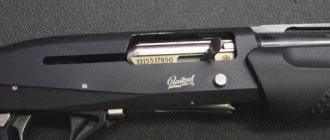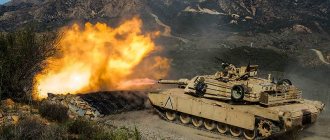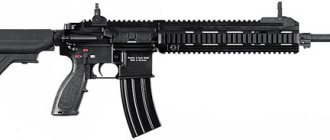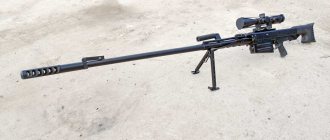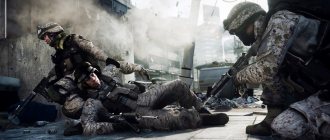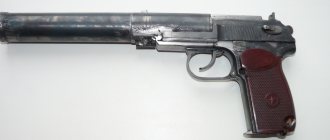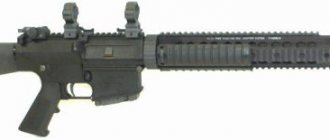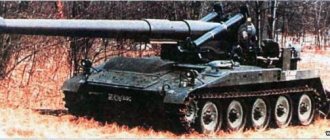M21 sniper rifle
M14
During the Vietnam War, the US Army quickly saw a growing need for an effective sniper rifle. Its creation was entrusted to a special army unit - Army marksmanship Unit. The new rifle was developed jointly by Army Weapons Command (Rock Island, IL), Combat Development Command (Ft. Benning, Georgia) and Limited Warfare Agency (Aberdeen, MD).
The simplest solution to creating a new sniper rifle was to re-equip the semi-automatic M14 rifle that was in service (more precisely, its version specially modified for shooting competitions, the M14 National Match - M14 NM) with a specially designed ART (adjustable rangefinder) optical sight.
For conversion to M21 sniper rifles, M14 rifles with the best accuracy of fire were specially selected.
XM21 in a wooden stock
The new sniper rifle was designated XM21.
In 1969, the Rock Island Arsenal modified over 1,400 M14 NM rifles into the XM21 variant, and most of them were sent to Vietnam. Some of the rifles were additionally equipped with a Sionics shot sound suppressor (the silencer did not affect the initial velocity of the bullet, but reduced the speed of the powder gases to subsonic).
M21 in use
In 1975, the rifle from experimental (index XM21) acquired the status of officially being in service (index M21), and was used by the US Army until 1988, when it was replaced by the M25 sniper rifle. However, M21 rifles remained in service with the troops and in the National Guard until the 1991 war with Iraq.
In addition, M21s were used during military operations in Iraq and Afghanistan at the beginning of the 21st century.
The M21 sniper rifle is a self-loading weapon that uses gas-operated automatics with a short-stroke gas piston located under the barrel. The barrel is locked by turning the bolt (Garand scheme).
The M21 rifle differs from the M14 in the high precision of its barrel. The gas chamber and piston are hand-machined and polished to improve operating efficiency and reduce carbon deposits: the gas chamber and the lower stock ring are fixedly connected to each other.
| M21 |
The trigger mechanism is hand machined and has polished surfaces. The trigger force is adjustable from 2.0 to 2.15 kg.
The XM21 rifle had a solid wooden stock with a pistol grip on the neck. The stock was impregnated with epoxy resin. Later, the stock of the M21 rifle was made of fiberglass.
Unlike the mass-produced linear M14, the M21 receiver and stock were individually fitted and bonded together with a layer of epoxy resin.
| Caliber, mm | 7.62×51 NATO (.308 Winchester) |
| Weight without cartridges, kg | 5.27 |
| Length, mm | 1118 |
| Barrel length, mm | 560 |
| Initial bullet speed, m/s | 853 |
| Sighting range, m | 800 |
| Magazine capacity, no. cartridges | 5, 10, 20 |
The M21 rifle retained the adjustable sights of the M14 rifle (diopter rear sight and front sight). The optical sight bracket was installed on standard seats made on the left side of the receiver of all production M14 rifles. The rifle was equipped with a Leatherwood 3X-9X Adjustable Ranging Telescope (ART) optical sight (with a rangefinder sighting reticle), or a night sight, on a special bracket that provides automatic correction for firing range for the M118 cartridge (a variant of the 7.62x51 NATO cartridge, optimized for high-precision shooting ).
The Leatherwood 3X-9X ART optical sight allows you to fire at ranges up to 1000 m with a maximum effective range of 600-800 m. The sight has two rangefinder marks on the horizontal reticle, corresponding to 152 cm at a distance of 300 m with a threefold increase, and two on a vertical thread, corresponding to 76 cm under the same conditions. For clarification: the distance from the top of the helmet to the soldier’s waist belt can be taken as 76 cm, i.e. at a distance of 300 m. with a threefold magnification, it falls between two marks on a vertical thread. If the range is more than 300 m, then it is necessary to enlarge the image until it matches the gap between the two marks.
It is clear that the increase is directly proportional to the range: the same height value with a 9-fold increase corresponds to a range of 900 m, and with a 3-fold increase - 300 m. This principle allows the sniper to quickly and accurately determine the distance to the target. In addition, the adjustment ring has a ballistic eccentric, which, when setting rangefinder marks, automatically shifts the sight axis vertically in accordance with the ammunition used.
The rifle can be equipped with an adjustable folding bipod.
The circular probable deviation of the M21 sniper rifle does not exceed, on average, 15 cm at a range of 300 m.
According to special orders, it launched the production of the M21 modification with a modified barrel. To better stabilize the bullet in flight, the barrel has slightly steeper rifling: the rifling stroke length is 254 mm. versus 305 mm, usual for the 7.62x51 cartridge. The barrel is placed in the stock on a rubber-fiberglass gasket.
There is also an M21 variant with a fiberglass stock and a 10x or 3-9x scope.
In addition, a variant of the rifle was developed for US special operations forces under the symbol M25, which differed from the M21 in a more advanced plastic stock from McMillan and more modern optical sights from Baush & Lomb or Leupold on new brackets.
Performance characteristics of Tavor TAR-21
– Adopted: 2001- Designer: Zalman Shevs. Boron Erez. Amnon Shiloni. Moti Rosen - Developed: 1993 - Manufacturer: Israel Weapon Industries
Wes Tavor TAR-21
– 3.27 kg (TAR-21); 3.18 kg (CTAR-21); 3.67 kg (STAR-21); 2.95 kg (MTAR-21); 3.19 kg (TC-21) without magazine
Dimensions Tavor TAR-21
– Length, mm: 725 (TAR-21, STAR-21); 640 (CTAR-21); 590 (MTAR-21); 670 (TC-21) - Barrel length, mm: 460 (TAR-21, STAR-21); 380 (CTAR-21); 330 (MTAR-21); 410 (TC-21)
Cartridge Tavor TAR-21
– 5.56×45 mm (M193/SS109); 5.45x39 mm (for MTAR-21 X95R and Fort-221.224); 9x19mm Parabellum, .40 S&W (optional for MTAR-21)
Caliber Tavor TAR-21
– 5.56 mm; 5.45 mm (for MTAR-21 X95R and Fort-221,224); 9.40 mm (optional for MTAR-21)
Rate of fire Tavor TAR-21
– 750—900; 1200 (TAR-21 X95S) rounds/min
Tavor TAR-21 bullet speed
– 910 (TAR-21, STAR-21); 890 (CTAR-21); 870 (5.56 mm MTAR-21); 885 (TC-21) m/s
Tavor TAR-21 magazine capacity
– box magazine for 20/30 rounds; extended from 60 rounds to 100 rounds (STANAG); 20/25/32 rounds (9 mm MTAR-21)
Sighting range, m:
– 550 (STAR-21); 500 (TAR-21,CTAR-21); 150 on the chest target; 300 on a full-height target (MTAR-21)
Operating principles: removal of powder gases, rotary bolt, bullpup
Description
M21 based on the AK-47 Kalashnikov principle, chambered in a 5.56×45mm NATO cartridge. Current models use a 1.5mm thick stamped receiver, while the future model will include an improved 0.9mm thick receiver to achieve a significantly lighter weight. As with many modern assault rifles, the M21 may include a Picatinny style for mounting accessories such as optics, vertical grips, bipods, etc.
Zastava M21 is a gas vent with a rotating locking bolt system. It has a hard chrome plated, cold forged standard rifled or optional polygonal rifled barrel, integrated 22mm grenade launcher flash hider, hard polymer folding stock, heavy duty synthetic handguard with optional left fire side selector, Picatinny mounted cover for optical sights. The rifle can also mount a 40mm grenade launcher. It has a magazine capacity of 30 rounds. The cyclic rate of fire is 680 rounds per minute, and the sustained rate of fire is 120 rounds/min.
The Zastava M21 uses a regular barrel, while the Zastava M21B uses a polygon barrel. The regular barrel has six flutes with a right-hand twist. An octagonal polygonal version is also available and has four right-hand twist grooves (M21B). The barrels are also hard chrome plated to ensure a longer service life.
The rifle has conventional iron sights which consist of a front post and flip rear sight with 300m and 500m holes. A set of Picatinny rails on the guard's arm can mount various optical-electronic devices. The M21 is a modular weapon, with configurations depending on the assigned mission and mission.
Optical sight choices include “Teleoptik” (ON M04) and “ZRAK” (ON M04A). Optoelectronic devices include a reflex sight ("MARS" M04), two target lasers ("AIM2000" M04A and "INFIZ" M04), two passive monoculars (M04 MINI N/SEA and "MARS" M04 + MINI N/SEA), a passive sight (“OWL” PN 3×50).
Peculiarities
The accuracy of the M14 National Match is:
- when using M118 cartridges - 2.03 MOA Ex.Ver. (range 100 m, series of 5 shots);[3]
- when using M852 cartridges - 1.07 MOA Ex.Ver. (range 300 m, series of 5 shots);[4]
This roughly corresponds to the performance of the Dragunov sniper rifle:
- when using the 57-N-323S (LPS) cartridge - 2.21 MOA Ex.Ver. (range 300 m, series of 5 shots);[5]
- when using the 7N1 sniper cartridge - 1.24 MOA Ex.Ver. (range 300 m, series of 5 shots);
- when using the 7N1 sniper cartridge and with a barrel rifling pitch of 320 mm - 1.04 MOA Ex.Ver. (range 300 m, series of 5 shots).[6]
Notes
- ↑ 12345678910
Rifles and machine guns M1 and Mark 2 • M1918 • • M14 • M15 • M16 • XM22/E1 • XM106 • XM70 • FN SCAR • HK416/M27 Carbines M1/M2 • XM177/E1/E2 and GAU-5/A • Colt Model 653 • M231 • M4/A1/E2 • GUU-5/P • Mark 18 Sniper rifles M14SE • M21 • M24 • M25 • M39 • M40 • M82 and M107 • M88 and Mark 15 • M110 • Mark 11 • Mark 12 • Mark 14 • DMR • RC-50 • SAM-R • SDM-R • M2010 Submachine guns Thompson • • Smith & Wesson M76 • MP5/K Guns Ithaca M37 • Remington 870 • Mossberg 500/590 • M1014 • XM26 Machine guns M60 series and Mark 43 • XM207/E1 and Mark 23 • M73/M219 • M85 • M240 • Stoner 63 • M249 series and Mark 46 • XM262 • XM312 • Mk 21 • EX 27 • Mark 48 • Browning M2 • GAU-19 • M134 Minigun • LW50MG • LWMMG Hand grenade launchers M79 • XM148 • M203 • M234 • M320 • M32 • EX 41 • Mark 13 Automatic grenade launchers M75/M129 • XM174 • Mark 19 • Mark 47 • XM109 • XM307 Other weapons XM25 • M20A1/A1B1 • M67 • M72 series • M136 (AT4) • M141 • M202/A1 • Mark 153 • FIM-43 Redeye • FIM-92 Stinger • FGM-172 SRAW • Ammo 7.62x33mm • 5.56x45mm NATO • 7.62x51mm NATO • .30-06 Springfield • 12.7x99mm NATO • .300 Winchester Magnum • 9x19mm Parabellum • .45 ACP • 12 gauge
Canadian Scottish Baronet Rifle: expectations and reality
In the summer of 1904, the Royal Canadian Mounted Police received the first batch of Ross rifles for testing - the brainchild of the Scottish baronet Charles Ross, who loved money, hunting and small arms. Unable to negotiate supplies with England, the Canadian government entered into a contract with Sir Charles to produce thousands of rifles locally, which, although they had certain shortcomings, made it possible to close the gap in the soldiers' armament. However, relations with these weapons did not develop very smoothly, and the First World War revealed its additional shortcomings.
These are all insidious enemies
The first reports from the front were relatively good. For example, Lieutenant Colonel G.B. Hughes reported that “the Ross rifle is not an ideal mechanism,” but at the same time Fr. However, more and more, and the reviews became more and more categorical:
«Most rifles cannot be fired quickly
»;
«after 15–30 shots at a fast pace, the rifles jam. You must use the heel of your boot to release the bolt.
».
Canadian with “Ross”
Despite the fact that some of the problems were related not to the rifle itself, but to British-made ammunition, the confidence of the soldiers had already been undermined. During the Battle of Ypres, 1,452 of the 5,000 Canadian soldiers threw away their Rosses, obtaining Lee Enfields from the wounded or killed. In the summer of 1915, having received reports that the Rosses were functioning normally only with Canadian-made ammunition, the commander of Canadian forces in Europe decided to “immediately rearm the division with Lee-Enfield rifles.” So far, the conversation was only about a temporary replacement, and the commander even had to justify himself, saying in letters that “in my reports I never condemned the Ross rifle” and that it was exclusively about problems with the shortage of Canadian-made ammunition, due to which more than 3000 the fighters managed to arm themselves with “Lee-Enfields” instead of “Ross”, as they say, in a spontaneous manner.
At this point, Canadians still didn't have much of a choice. Even in April 1916, one of their battalions arrived in England unarmed. A month earlier, the Canadian Prime Minister had cabled the British asking if they could get Lee Enfields or “some other rifle” from them, and received the answer that the British Government could not provide them with a single gun. It is not surprising that when earlier Sir Charles tried to hint that if you don’t need my rifles, let me take care of the Russian order, they immediately explained to him how wrong he was.
At the same time, work was carried out at a feverish pace to eliminate problems with increased sensitivity to ammunition. It was believed that it would be possible to get rid of them by changing the tolerances in the production of the “too sporty” chamber.
In the meantime, the 2nd Canadian Division tried to experimentally determine which ammunition would work normally in the Ross and Lee Enfield. The result was disappointing for the Canadian rifle. When firing British-made cartridges, the Ross shooter had to open the bolt with a kick already on the 26th shot, and on the 40th shot the bolt jammed, and the rifle was declared out of order. Of course, this did not increase the troops’ confidence in their rifles. Despite a series of orders to hand over “non-standard” British Lee Enfields to a warehouse with a threatening ending: “Neglect of this order will be considered a direct violation of discipline,” the number of Lee Enfields among Canadian soldiers continued to grow, and not without the connivance of the officers. As one of them wrote,
«this order was carried out until the second battle of Ypres. Battle experience showed that the Ross jammed so badly that I was forced to let this order die a natural death
».
Sniper with Ross rifle
Perhaps the only unit where the “Russians” performed well was the 28th battalion, which took part in the “mine battle” for Hooge in April 1916. This could be due to the instructions compiled by one of the company commanders, a former shooter of the Canadian rifle team in Bisley. However, the position of the Canadian leadership was still that the Ross rifle was no worse than the Lee-Enfield rifle, with which, according to their information, there were also a lot of problems. It never came to the point of declaring the distributors of “fucking rumors” enemies of the entire Canadian people and sending them to the lumber camps of Alberta or to clear snow in the Arctic Circle. Although, judging by the letters of one of the main supporters of the Ross rifle, the Canadian Minister of Militia and Defense Samuel Hughes, he at times regretted the lack of such an effective tool for gagging at his disposal.
Only in 1916 did Canadian front-line soldiers finally manage to convince their command that the rifle, which had performed well in peacetime in sporting competitions, was not entirely suitable for trench mud. It also helped that the British, albeit reluctantly, agreed to allocate some of the rifles produced in the USA to their order to the fighters from the dominion. In August, the 2nd and 3rd Canadian Divisions were re-equipped with Lee Enfields. The 4th Division received them only in September, after arriving in France. The 5th Division received 300 SMLE per battalion in November. Subsequently, in Canadian units, only snipers retained the Rossa, for whom the advantages of these rifles outweighed the disadvantages.
Sniper scope for Ross rifle
On you, God, what is not good for us
The refusal of Canadian units from the "Ross" caused the following problem: where to put both the already released rifles and the result of the latest government order for 100,000 units? The Allied representative offices in London unanimously refused the “gift.” The prospects for supplies to China also turned out to be dubious. 20,000 "Ross" at a price of 12.5 dollars, including a bayonet, and 4,629,470 cartridges for training purposes were purchased by the United States in November 1917. It is unlikely that this contract was much consolation for Canadian officials, who had to pay $2 million to Sir Charles for the nationalized factory. Taking into account the 342,040 rifles previously purchased by the Canadian government, we can confidently say that the baronet made good money on this deal.
At the same time, rifles began to fall into the wrong hands. The Rossas confiscated from the Canadians were sent to ships and coastal posts of the Royal Navy to replace the Lee Enfields needed in the trenches in the weapon racks. Meanwhile, the fleet's small arms were a desirable target for the Irish rebels, who were desperate for modern weapons, preferably chambered in the British .303 cartridge. For example, the three Irish Republican Army (IRA) brigades in County Cork had approximately 8,000 volunteers, but few of them were armed. When, in November 1919, a motor launch that patrolled Bantry Bay in the west of the county moored overnight at the pier in the town of the same name, local fighters for a free Ireland took it as a gift from God. Having killed the sailors, they escaped with Ross rifles, several revolvers and a large box of ammunition. The catch was subsequently handed over to the headquarters of the 3rd West Cork Brigade for distribution among the fighters, and until then it was hidden in a local church. According to the recollections of Liam Deasy, one of the rebels, Canadian Ross rifles
«became a welcome addition to the brigade's armament. They were later put to good use in many important battles
».
Armory workshop of Canadian units, 1917
Although the Lords of the Admiralty noted the very fact of the threat to lighthouses and coast guard stations scattered in secluded places along the coast, they underestimated its scale. In June 1920, the 8th "Special" Battalion, Royal Marines, was formed and dispersed in small detachments along the west coast of Ireland, from Donegal in the north to Cork in the south. Given the situation in Ireland, it would be easier to ship the rifles directly to the IRA fighters - this would save the lives of the Marines.
However, most of the Ross rifles, especially after the end of the Great War, were distributed around the world, ending up in service with many countries - from fragments of the Russian Empire to the armed forces of Luxembourg. This issue is partly confused by the naming of the English P14 rifle (.303 Pattern 1914 Magazine Rifle) “ross-enifld” in some sources. In particular, this is the naming given in the famous book by A.B. Beetle, although this was never the official name and Sir Charles has no direct connection with this model. In justification, it can be noted that, for example, the Lithuanians named their rifles the same way back in the 1920s.
Americans with training "ross"
Regarding the “Russians” in the USSR, one can recall the 40,000 rifles transferred by the British to the armies of Georgia and Armenia. During the Civil War, they became trophies of the Red Army, and then for many years they became one of the favorite models of Soviet sports shooters - until the .303 cartridges captured along with the rifles “overstayed” their shelf life, ceasing to provide the necessary performance when shooting. sports indicators. But this did not put an end to the Russians’ sports career in the USSR. After the Great Patriotic War, Tula TsKB-14 (since 1960 TsKIB SOO) converted a number of Canadian rifles into MTs-17 sports rifles.
Is it really that bad?
If we talk about Sir Ross’s rifle itself, then its shortcomings, in general, became a continuation of its advantages. Despite his experience in military service, the baronet was still more of a hunter and sports shooter than a military man, who well understood the peculiarities of the use of weapons in war, and even more so in a big war. At the same time, technically there was time to “cure” at least part of the shortcomings of the early “Russians”: many subsequently known samples at the time of their birth were also not very impressive. However, before the outbreak of the First World War and the emergence of problems associated with it (a drop in the quality of ammunition, poor training of recruits, and finally, just trench mud), the Ross rifle looked like a quite worthy weapon.
Snipers with "ross"
Besides, the Canadian government didn't have much choice anyway. At the beginning of the 20th century, Lee Enfields cost $27.35, and Canadians were promised them at best someday. Ross rifles made in Canada cost $26.9, plus the Canadians still had the arms factory built by Sir Charles.
On the other hand, the rifle also had undoubted shortcomings. The design of the shutter especially contributed to the loss of confidence. The soldiers were ordered not to disassemble it, but many did not follow this order, as another one of the participants in the first tests warned about, and it was intuitively even easier to assemble the Ross bolt incorrectly than in the correct order. Contrary to rumors, the incorrectly assembled bolt did not fly out of the rifle, but when fired, it went back almost the entire length, stopping only at the end. If at that moment the shooter's face was pressed against the butt too close to the rear sight, then the consequences could be very unpleasant.
It's easy to see why Canadian soldiers quickly fell out of love with their accurate, easy-to-handle rifle. What is good in days of peace is not always so good in war.
Martin Kovacek
/
"Colt" for Alec Baldwin
The story of a revolver that killed a century and a half ago and continues to kill
- weapon
- USA
- the best
- 19th century
Andrey Ulanov
/
When the second one is not worse than the first one
John Browning Pistols: M1903 Takes the Podium
- weapon
- USA
- Belgium
Andrey Ulanov
/
Weapons with a stormy biography
The Guns That Shook the World: John Moses Browning's Early Designs
- weapon
- USA
- the best
- Belgium
